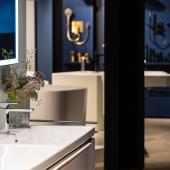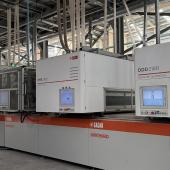Design trends: virtual exoticism
Pamela Albanese - TosiLab
Classical architectural forms are so familiar to us because they are to be found not only throughout Italy but in much of the western world thanks to the post-classical movements that have repeatedly arisen throughout the history of art. So it is hardly a surprise that the classical style re-emerges powerfully from time to time.
The precise opposite of this trend in the field of applied and visual arts is the diffusion of forms, effects, colours and references arising from the composition of elements using digital programs and tools for three-dimensional printing. This has led to the emergence of a new aesthetic that is not associated with any culture on Earth, an aesthetic devoid of ethnographic origins, geographical characteristics or an iconic personality. It originates in a “non-place”, a “virtual world” that has no connection with physical reality but which we can relate to because it has already been assimilated into contemporary visual culture. In other words, software languages generate aesthetics and geometries that are only possible with automated computing systems. This digital method is manipulative in that it deconstructs and effortlessly corrects simple forms.
The basic assumption is that the opportunities opened up by the convergence of the real and digital worlds allow us to develop new aesthetic codes which in turn generate novel stylistic cues, redefining product aesthetics and laying the foundations for what we can call “virtual exoticism”.
High-tech perspectives undermine the cornerstones of the traditional cycle of industrial design based on project-production and distribution-consumption. Ideas are increasingly being shared and discussed on web platforms, opening up the possibility of many different avenues of development. This framework of sharing means that languages and products are no longer offered uniquely by companies/designers to consumers/users but increasingly arise from the mutual interaction between creator and recipient. In this scenario the most striking phenomenon is that of Open Design, an archive of source documentation of design products available on a digital platform to allow anyone to analyse, alter, prototype, produce and distribute a given object.
In particular, it leads to anthologies of eccentric decorations. Extravagant symmetries and compositional devices are the ingredients of a design that returns to the dynamic use of colour as a starting point for research and experimentation. The expressive languages of art and graphics enhance optical illusions. In the field of textiles we are seeing a proliferation of extravagant floral motifs deriving from embroidery that emerges from the flat fabric, creating an illusion of movement. The site-specific artist Elena Manfredini alters the perception of public spaces or urban buildings by using three-dimensional patterns and decorations to create original spatial landscapes.
In addition to technical and aesthetic references to the plant kingdom, exoticism also focuses on cellular organisms and their natural geometric flexibility: many technical materials are inspired by the organic structures of animals, such as honeycombs, the liveries of insects, scales and the irregular polygons that make up the skins of reptiles.
In interior design we are seeing a return to transparency motifs based on a digital approach. This includes examples of interaction between pearly reflections, reflective disks, glints of natural light inspired by underwater worlds, dreamlike opalescence and scintillating holographic effects (as in the use of glass made by Glass Italia in the Shimmer collection designed by Patricia Urquiola).
The Academy of Design and Craft of Gothenburg plays with observers’ perceptual abilities and challenges them to discern between what is real and what is merely an optical-digital effect around (Un)Spaced, an installation composed of translucent glass.
We are also seeing a clear intention to contaminate materials, which by their nature are static, and to give them a digital-dynamic quality. In recent weeks an interesting example was on display at the Stockholm Design Week, where Jessica Andersdotter designed hybrid textiles with integrated optical fibres that activate intermittently to create a dynamically fluorescent garment.
But let’s return to the influence of digital technologies and focus on the creation of visual scenarios that diverge from traditional Euclidean geometries.
One of the best examples is that of New York-based designers Aranda/Lasch who combine shape-generating software with elegant artisanal production to create architecture and furnishings. This leads to structures that recall the grammar and compositions of cyberspace, which are familiar to us as they have been assimilated by our visual culture. Sometimes they take the form of a soft sign written into the body of an object and deriving from the visual layout of graphic user interfaces. On other occasions they appear as a less pacific confrontation between digital and material. For example, the lamps in the A Greater Scale collection by David Taylor for BERG Gallery in Stockholm represent the union of precise two-dimensional elements such as geometric figures with rough, raw blocks of material. The effect is that of a juxtaposition between linear, precisely defined two-dimensionality and solid, imperfect three-dimensional objects.
- Read the complete article published on Ceramic World Review 120/2017
Did you find this article useful?
Join the CWW community to receive the most important news from the global ceramic industry every two weeks




















